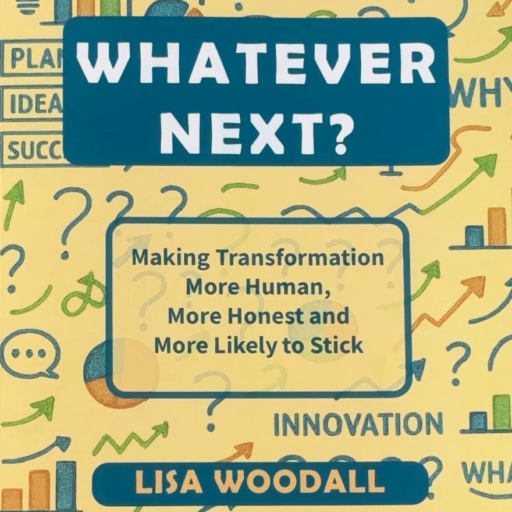When I was writing Whatever Next?, I wasn’t starting with a blank page. Alongside lived experience and countless conversations, certain books became touchstones. They gave me language, perspective, and sometimes the provocation I needed to see transformation differently.
Here are the ones I leaned on most — and how they connect back to the lenses in Whatever Next?.
What Matters Next by Kate O’Neill
Kate’s work reminded me that technology without humanity misses the point. What Matters Next is a powerful exploration of how organisations can navigate emerging technologies while staying anchored in values and purpose. She challenges us to think beyond shiny new tools and instead to ask: what kind of future are we creating, and who is it really serving?
The book weaves together strategy, ethics, and foresight, showing that the choices we make about technology are inseparable from the choices we make about people. That balance between innovation and humanity is where the real work of transformation lies.
You can feel its echo in the Reconnect lens of Whatever Next?, where I argue that transformation sticks only when we see and design for the human experience at its core. It reminded me to look not just at the formal mechanisms of change, but at the informal, human truths — the stories colleagues share in the corridor, the sense of pride or frustration in their work, and the way people ultimately experience the change we create.
Strategy to Reality by Whynde Kuehn
Whynde’s book is a masterclass in translating ambition into execution. It reinforced my belief that architecture is not about drawing boxes but about building bridges from intent to reality. She captures the discipline of business architecture not as a technical exercise, but as a way of thinking — one that makes strategy tangible, actionable, and sustainable.
That mindset shaped the Reframe and Rewire lenses in Whatever Next?. In Reframe, it shows up in the discipline of making clear choices about what to say “yes” to, and ensuring those decisions cascade consistently through the enterprise. In Rewire, it becomes the foundation for building operating models that are coherent, connected, and able to actually deliver on strategy.
Thinking like a business architect is a superpower in transformation programmes. It forces us to see both the forest and the trees — the enterprise-level coherence as well as the day-to-day mechanics. It ensures transformation doesn’t stop at vision statements or new structures but translates into lived reality for colleagues, customers, and partners.
EDGY Foundations by the Intersection Group
The EDGY model of identity, architecture and experience facets has been part of my toolkit for the last couple of years. It offers a shared language for transformation, one that helps us see misalignments and find coherence.
You can see its strongest influence in the Rewire lens of Whatever Next?, where I argue that rewiring the operating core isn’t just about changing processes or structures — it’s about connecting them back to the three facets so the whole enterprise holds together. EDGY sharpened my ability to show that without this coherence, transformation unravels.
It also informed Reimagine, by emphasising how collective vision and purpose must be shaped across all aspects of change not just from a single perspective. And in Reconnect, it reinforced the truth that transformation isn’t sustainable unless human experience is part of the system we’re building.
Look and Sensemaking by Christian Madsbjerg
These books are discoveries from the last twelve months, and they opened up a whole new dimension for me. The power of anthropology — the study of culture, behaviour, and meaning — is a fascinating and often overlooked side of transformation. We spend so much time measuring outputs and building structures, yet the richest insights often come from simply paying attention to how people live, work, and interpret the world around them.
Christian Madsbjerg’s writing encouraged me to pause, to observe, and to truly notice. His work influenced the Reflect lens — the reminder that before we race into solutions, we need to be honest about where we’re starting from and attuned to the meaning unfolding in human life. Reflection without sensemaking risks being surface level; his books pushed me to go deeper.
They also nudged me to see that data alone isn’t enough to make transformation stick. Without cultural context and human interpretation, change efforts can miss the point entirely. Anthropology invites us to listen with intent, notice the patterns that people themselves may not articulate, and weave those truths back into how we design for the future.

